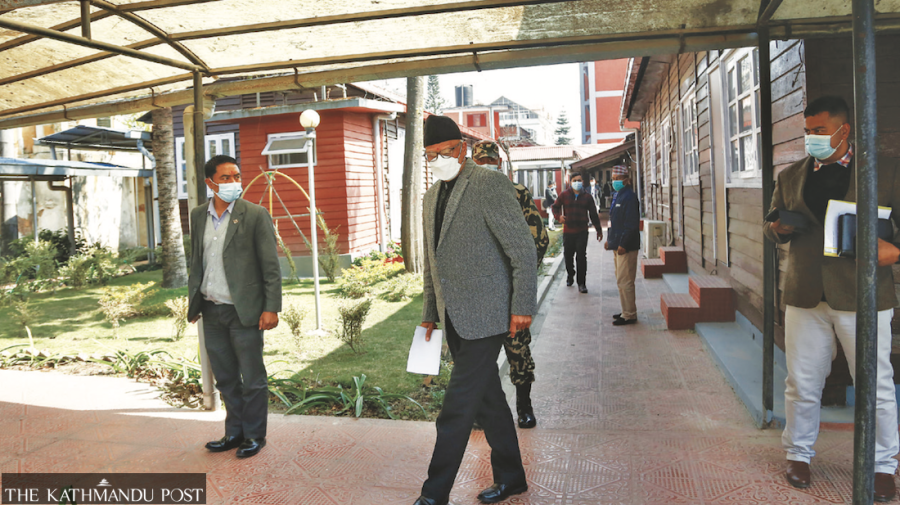National
What impeachment motion against chief justice is and how it will proceed
Rana’s been suspended, but what it takes lawmakers to actually remove him from office.
Binod Ghimire
Three ruling parties on Sunday registered an impeachment motion against Chief Justice Cholendra Shumsher Rana at the Parliament Secretariat.
As many as 98 lawmakers from the Nepali Congress, Communist Party of Nepal (Maoist Centre) and the CPN (Unified Socialist) registered the motion, said Gopal Nath Yogi, secretary at the House of Representatives.
The impeachment motion against Rana, who has been in controversy since October last year, from the ruling partners comes at a time when they were at loggerheads over parliamentary ratification of the Millennium Challenge Corporation compact involving a $500 million American grant.
The impeachment motion was proposed by Pushpa Bhusal, a whip of Nepali Congress, and Dev Gurung and Jeevan Ram Shrestha, chief whips of the Maoist Centre and the Unified Socialist. The proposal was seconded by 95 lawmakers from the three parties.
Rana is the second chief justice to face an impeachment motion after Sushila Karki in 2017. Filing an impeachment motion has led to automatic suspension of Rana, but the motion needs to be endorsed for him to get impeached.
Here’s all you need to know about the impeachment motion against Rana and how it will move ahead.
Which article of the constitution allows lawmakers to file an impeachment motion?
Article 101 (2). It says one fourth of the members of Parliament can register an impeachment motion against any official holding a constitutional position on the ground of failing to perform duty effectively or working against the constitution or seriously violating their code of conduct.
What’s the status of Rana now?
Rana is suspended. Immediately after a letter regarding the motion against him was sent to the Supreme Court, he was suspended. As per Article 101 (6) of the constitution, an official holding a constitutional position is not allowed to discharge his or her duties until the Parliament decides on the motion. Deepak Kumar Karki, the senior-most justice at the Supreme Court, has taken charge as acting chief justice.
Rana can return to work only if the lower house fails to endorse the motion by a two-thirds majority.
What does it take for an impeachment motion to pass?
A two-thirds majority of the (currently) 271-strong lower house can pass the motion. That means 181 lawmakers must vote in favor of the motion. As the Nepali Congress (61 lawmakers), the Maoist Centre (49 lawmakers) and the Unified Socialist (23 lawmakers) together have 133 votes combined, the support of additional 48 lawmakers is a must for its approval. The motion cannot get through the Parliament without the support of the CPN-UML, the single largest party which has 98 lawmakers at present. The main opposition party, however, has objected to the motion.
What is the procedure now?
Now it is up to the lower house to decide Rana’s fate. There, however, are some necessary steps that need to be followed before the motion is put to a vote.
As per Rule 161 (2) of the Regulation of House of Representatives, the Speaker can present the motion for discussion in the House seven days from the date of its registration. As the motion was registered on Sunday, its discussion can start on February 20. However, it is up to the Speaker when to table it for discussion.
Once the discussion is held, it needs to be studied by the Impeachment Recommendation Committee to be formed as per Article 101 (3) of the constitution.
The 11-member committee has the authority to examine whether there is any ground and reason for moving a motion of impeachment. As per the regulation, the Speaker can form the committee after consent from the Business Advisory Committee. The House needs to approve the names selected by the Speaker for the recommendation committee.
“It is up to the Speaker when the motion is tabled and when the recommendation committee is formed,” Roj Nath Pandey, spokesperson for the Parliament Secretariat, told the Post. “Tabling of the motion and the formation of the committee can be done in a single day.”
The recommendation committee has the representation of lawmakers from the major parties in the lower house, which are the CPN-UML, the Nepali Congress, the Moist Centre, the Unified Socialist, Janata Samajbadi Party and the Loktantrik Samajbadi Party.
As the CPN-UML, the main opposition, is obstructing the House proceedings for the last five months in protest against Speaker Agni Sapkota, it is not clear whether it provides the names of its lawmakers for the recommendation committee.
If a preliminary study by the recommendation committee finds that the person to be impeached has violated the constitution or has failed to discharge his/her duty, it can start further study.
Before that the preliminary reports need to be endorsed by one-fourth members of the House.
The recommendation committee has a maximum of three months to study and submit a report before the House. Discussions on the report then start and any member of the Parliament can register an amendment to it. The House can also direct further study in a week.
As per Rule 166 of the regulation, the report of the recommendation committee will then be put to a vote. If it gets endorsed by the two-third majority of the existing members of the lower house s/he will be relieved from her/his office.
The person who is impeached by the Parliament will be disqualified to hold any public post in the future. Though impeachment motions were registered against Sushila Karki, and a former chief commissioner of the Commission for Investigation of Abuse of Authority, Lokman Singh Karki, none of them got parliamentary endorsement.
Is there any legal deadline to finalise the motion?
No. So it could even take months, experts say. “It is up to the Speaker whether to conclude it early or delay it,” said an official at the Parliament Secretariat.
Rana retires on December 12.
Can the motion be challenged in the Supreme Court?
Even as the Parliament takes its course, there are chances that petitions can be filed against the impeachment motion in the Supreme Court. When a petition was filed against the impeachment motion against Karki by advocates Sunil Ranjan Singh and Kanchan Krishna Neupane, the then acting chief justice Gopal Parajuli had assigned the case to a bench led by Rana, who was then a justice at the Supreme Court and is now facing impeachment.
A single bench led by Rana on May 5, 2017 stayed the impeachment motion, saying “the move to impeach the chief justice is against the spirit of the Constitution of Nepal.”
The Nepali Congress and the Maoist Centre, which had filed the motion against Karki, withdrew it on June 6, a day before her mandatory retirement.




 4.91°C Kathmandu
4.91°C Kathmandu







%20(1).jpg&w=300&height=200)






